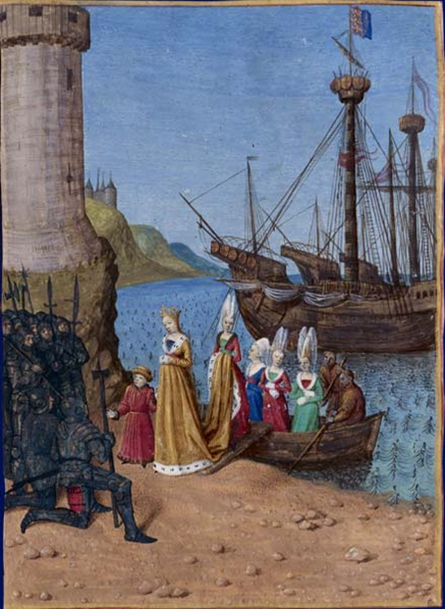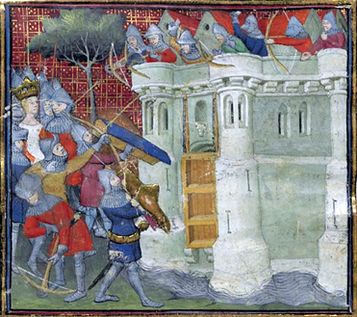 Isabella of France landing at Harwick Harbor, England accompanied by her son Edward, Grandes Chroniques de France, Jean Fouquet, 1455-60 CE © Bibliothèque nationale de France, Paris, folio 338v, (Book of Charles IV le Bell).
Isabella of France landing at Harwick Harbor, England accompanied by her son Edward, Grandes Chroniques de France, Jean Fouquet, 1455-60 CE © Bibliothèque nationale de France, Paris, folio 338v, (Book of Charles IV le Bell).
Isabella of France, 1292-1357
Ancestral Roots Line 101:31
Daughter of Philip IV of France and Joan I of Navarre, consort to Edward II. The twelve year old bride described by Geoffrey of Paris as "the beauty of beauties... in the kingdom if not in all Europe" arrived in 1308 during a period of growing conflict between the king and the powerful baronial factions due to Edward’s notorious patronage he lavished on his favorite Piers Gaveston. At their wedding celebration Isabella was forced to watch as Edward chose to sit with Gaveston, not receiving her own lands or household until her father Philip IV intervened. Although Isabella made an effort to get along with Gaveston his exclusive access to the King provoked members of the nobility and after numerous attempts to force him to leave England the barons were finally successful having Gaveston condemned to death for violating terms of the Ordinances in 1311.
In 1313, Edward and Isabella traveled to Paris where she gave newly embroidered purses to her brothers’ wives only to see the purses reappear later that year at a London dinner being carried by two Norman knights resulting in a scandal The Tour de Neslie concluding with life imprisonment of two sisters-in-law, execution of the knights and Isabella’s reputation in France suffering from her perceived role in the affair.
Isabella was forced to rely on her own instincts when Edward turned to a new favorite, Hugh Despenser the Younger. Once Hugh was firmly ensconced as Edward's new favorite and lover Edward and the Despensers imposed a harsh rule over England, a "sweeping revenge" characterized by land confiscation, large-scale imprisonment, executions and the punishment of extended family members, including women and the elderly. By 1324, Edward and the Despensers had confiscated all of Isabella’s lands, taken over her household, arrested and imprisoned all of her French staff and her youngest children placed into the custody of the Despensers.
Isabella of France, 1292-1357
Ancestral Roots Line 101:31
Daughter of Philip IV of France and Joan I of Navarre, consort to Edward II. The twelve year old bride described by Geoffrey of Paris as "the beauty of beauties... in the kingdom if not in all Europe" arrived in 1308 during a period of growing conflict between the king and the powerful baronial factions due to Edward’s notorious patronage he lavished on his favorite Piers Gaveston. At their wedding celebration Isabella was forced to watch as Edward chose to sit with Gaveston, not receiving her own lands or household until her father Philip IV intervened. Although Isabella made an effort to get along with Gaveston his exclusive access to the King provoked members of the nobility and after numerous attempts to force him to leave England the barons were finally successful having Gaveston condemned to death for violating terms of the Ordinances in 1311.
In 1313, Edward and Isabella traveled to Paris where she gave newly embroidered purses to her brothers’ wives only to see the purses reappear later that year at a London dinner being carried by two Norman knights resulting in a scandal The Tour de Neslie concluding with life imprisonment of two sisters-in-law, execution of the knights and Isabella’s reputation in France suffering from her perceived role in the affair.
Isabella was forced to rely on her own instincts when Edward turned to a new favorite, Hugh Despenser the Younger. Once Hugh was firmly ensconced as Edward's new favorite and lover Edward and the Despensers imposed a harsh rule over England, a "sweeping revenge" characterized by land confiscation, large-scale imprisonment, executions and the punishment of extended family members, including women and the elderly. By 1324, Edward and the Despensers had confiscated all of Isabella’s lands, taken over her household, arrested and imprisoned all of her French staff and her youngest children placed into the custody of the Despensers.
|
In 1325, when her brother, King Charles IV of France, seized Edward's French possessions Isabella, known for her diplomatic skills saw this as a perfect opportunity to resolve her situation with Edward and the Despensers under the guise of negotiating a truce for Gascony. Persuading Edward she would be able to negotiate with her brother Isabella returned to France to appeal to Charles for help. Charles began to make preparations to support her until he and his council were bribed by Hugh Despenser turning against her, persuading the Pope to order her return to her lawful husband and banishing her from France. Isabella moved to Hainault where she secured the support of John of Hainault, brother to Philippa who was betrothed to her son and began raising forces to oppose Edward in alliance with Roger Mortimer whom she had taken as a lover.
|
Isabella and Mortimer returned to England with a mercenary army quickly seizing the country and serving as regent for about 5 years until her son Edward joined in an attack on Nottingham Castle where she and Mortimer were captured. Mortimer was executed and the queen forced to spend the remaining twenty-eight years of her life at her own Castle Rising in Norfolk which she left to her favorite grandson, The Black Prince.
References and Further Reading
- Bell, Jean Le. The True Chronicles of Jean le Bel, 1290—1360. Translated by Nigel Bryant. Boydell Press, 2011.
- Fines, John. Who’s Who in the Middle Ages. Barnes & Noble Books, 1995.
- Froissart, Jean. Froissart Chronicles. Translated by Geoffrey Brereton. Penguin Books, 1978.
- Hale, Sarah Josepha Buiell, editor. Women’s Record or Sketches of all Distinguished Women. Harper Brothers, 1978.
- “Isabelle de France.” Foundation for Medieval Genealogy. ENGLAND, KINGS 1066—1603, Chapter 3. KINGS of ENGLAND 1154-1485 (ANJOU), EDWARD “Of Caernavon”, ISABELLE de France. Web. 08 October 2016. //fmg.ac/Projects/MedLands/ENGLAND,%20Kings%201066-1603.htm.
- “Isabella of France” Murphy, Heidi. Britannia. britannia.com/history/biographies/isabella_france.html
- Jackson, Deirdre. Medieval Women. British Library, 2015.
- Labarge, Margaret Wade. A Small Sound of the Trumpet, Women in Medieval Life. Beacon Press, 1986.
- Richardson, Douglas. Royal Ancestry: A Study in Colonial and Medieval Families. vol. 1 pp 76.8; vol. 36.iv. 2013.
- Weir, Alison. Queen Isabella: Treachery, Adultery, Murder in Medieval England. Ballentine Books, NY, 2006.
